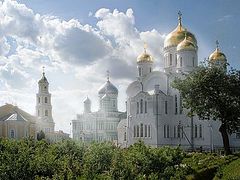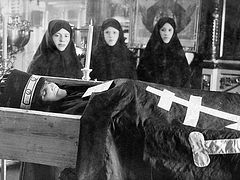During the New Year holidays, alas, for many, drunken and senseless, I went with a group of like-minded friends to the Fourth Portion of the Most Pure Mother of God.
I had been here before, but either you need to be especially ripe for such trips, or perhaps it depends on other factors, but it was precisely during this trip that I was able to see what I had long ago and without any real results searched for in and around myself. Diveyevo, the fourth and final portion of the Mother of God, revealed to me if only a small part of its mystical secret in the measure that I was ready to accept. I have certain thoughts on this matter and I hasten to share them with you. I’ll start with the history that most people know of the monastery or its meaning for Russia, and then some historical metaphors and parallels that were born under the impression of the Nativity services, prayer along the Canal, or immersion in the holy springs.
I was pleasantly surprised by the number and quality of the pilgrims—throughout the four days that I spent in Diveyevo, the churches were full; there were many men and couples, and not a few children. Furthermore one could feel that they had a conscious awareness of why they where here and what they were doing—these people from all corners of the Russian land. It was touching to see the inspired, beautiful, and typically Russian faces, as if they had emerged from old photographs or paintings—not just bearded or headscarved physiognomies, but something more, which evoked tender feeling and even delight. Out of all the many such types, or momentary dialogues with them, I would like to note two.
A lesson from a panhandler
He was the kind you usually see in such places, of an uncertain age, a bearded beggar with a guitar behind his back, a sling bag with some scant clothing, and finally a box to collect money in with an interesting sign on it: “For the Faith, Putin, and Russia!” His eyes were unusual, they were clear like a child’s. He sat near the food tents on the monastery grounds and breakfasted sedately on a pirozhok. I wanted to give him some money, but he quickly stopped me. “No, no! It’s forbidden here! Only outside the gates.” I was surprised at his faithfulness to the monastery blessing concerning the collecting of donations and received a reasonable answer: “I don’t need such money. God sees everything!”
No comment here—a man in need is only doing what is allowed, and no more. But I have to admit that I wasn’t ready to receive such an elementary lesson from a panhandler. Immediately I recalled my numerous violations of all possible, seemingly unnecessary rules, direct prohibitions and instructions that cramped my style, even to my meanderings on the grass or running across the street on a red light. I was taken aback, I didn’t know what to say to this blessedly simple man, and didn’t thank him for his nonintrusive lesson on obedience. After all, I had always considered myself a monarchist, and had emptied more than one “inkpot” trying to convince my readers and friends that we have to deserve a Tsar and we have to begin with our own selves, with our fulfillment of the most elementary requirements and rules. After all, a true monarchy can only be conscious and self-sacrificing. But without humbling ourselves and having obedience—it’s impossible! We want happiness and blessedness in Russia, burning with the next—this time monarchist—idea, forgetting that for every idea there needs to be not ecstatic and fiery fighters and creators, but obedient and humble servants and zealous doers, which requires routine and scrupulous work on ourselves. We’re far from that, aren’t we?
A meeting in the trapeza
Another memorable meeting took place in the pilgrims’ trapeza [refectory] in the monastery, where “anyone who came here” could have something to eat. Everyone here is met with the same hospitality and St. Seraphim-like magnanimity. The only and applicable-to-all requirement is to take off your coat or jacket. At the same table with me was one of the large families that you meet in the monastery. I had noticed them earlier in the Holy Trinity Cathedral at the services: a pregnant young woman with a real Mona Lisa smile, her husband, a sturdy, steady, red-bearded giant, and two children—a three-year-old brother and five-year-old sister. It was a truly disappearing archetype of a Russian family that is like to be entered into the list of endangered species. They placed candles and prayed quietly; the children were not noisy, and were as peaceful and reverent as their ages would allow.
As they took their food the father told the children a short history from the Lives of the martyred sisters Faith, Hope, and Love, paper icons of whom were hanging on the opposite wall. He told them the story very unobtrusively as he was apparently used to doing at home—without moralism or moral teaching. And forgetting her porridge, the little girl began looking carefully at the martyrs’ faces, the youngest of whom was in any case older than her. She began asking for the details: how old were they, what sort of toys did they have… The child looked attentively at the paper copy and saw something that was unknown, missed, and ignored by us adults.
This was yet another lesson of a true parental example of Christian child raising that I had never assimilated up to then—and I’m already a grandfather! At the exit, while helping this wonderful family to put on their coats, I took advantage of the moment to ask them where they were from. “From Donetsk”, the woman answered, with a face that never lost its peaceful expression the whole time. “How do you manage to preserve such peace living on the frontline?!” tore from me involuntarily. She obviously did not understand me and expressed sincere surprise at my question. I didn’t want to confuse her any more, to perhaps remove the cover over this family’s secret, to lay bare the unavoidable family problems hid from others; after all, the most important thing was already obvious to me.
Korin was mistaken
In summarizing my observations, which (alas, temporarily) are now voiced, I understood that Pavel Korin was wrong in his famous painting, “Rus’ Departing”, created by the artist during the dark days of the theomachic regime. All the faces he painted of the hierarchs and church servants of that time showed us the irrevocability of that Russia’s departure, wept over many times and too late (as it often happens) by their contemporaries who had finally seen the light. Yes, remarkable, powerful personalities have departed to eternity—colorful figures who embodied that Rus’ which, as Korin announced, is no more! Glory be to God, he was mistaken. Rus’ has not gone out of existence—God did not allow that to happen. And I have found dozens of confirmations of this fact!
Rus’ has not departed, and in fact it couldn’t depart without fulfilling its main mission. It has hidden itself in the expectation of the glorious Second Coming of the Savior, for Whose Nativity people prepared themselves not only in Diveyevo! Incidentally, the whole time I was there, staying in the private sector, I never saw a single drunk, regardless of the open grocery stores that sell alcohol 24 hours a day. No, I will not try to say that the inhabitants and guests of this unique village all observe dry laws or keep the fast, but it is clear to me that as opposed to many other places in our Russia, there seems to be a special rite of self-restraint observed. There is an explanation for this of course; after all, in this mighty spiritual citadel—the outpost of a preserved Holy Rus’—a common prayer is raised to the Heavens at least twice a day! I do not even dare to think that it is left without attention or response!
It is known from reliable sources that during these drinking days not a single serious crime was committed in the region of Diveyevo, which cannot be said for the entire Nizhny Novgorod province [where Diveyevo is located]. And we also have the Holy Trinity-St. Sergius Lavra, Optina Monastery, and other monasteries where, I would like to believe, there is the same repentant, prayerful, self-restrained, Holy Russian atmosphere extending far beyond the monastery walls. In them is hidden the spiritual might of the Russian people, which is forged in repentance and Communion, and many hours of services and Vigil prayers.
May the full churches, pure faces, eyes open to God, and the not rare tears that cleanse away sins be acceptable to the Lord through the intercessions of Sts. Seraphim, Sergius, and the Optina elders! Rus’ is resurrecting, repenting, and becoming enlightened.
Having been permeated with quietude, having felt under my feet the abyss of my unwept-for sins, having caught a glimpse of my spiritual poverty through the fog of illusory prosperity, I don’t want to descend into moralizing and idle chatter. But I personally received in Diveyevo great spiritual consolation, which I have rushed to share with you, brothers and sisters. The most wonderful thing about this is that living in Russia, we have the absolutely unique opportunity to at any hour of the day or night, find our hidden and beloved of God, Holy Rus’.








